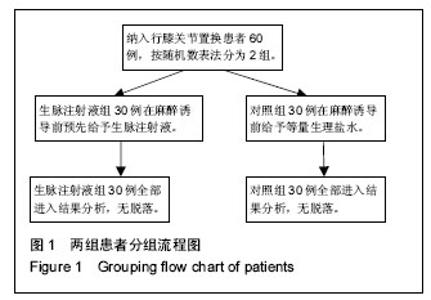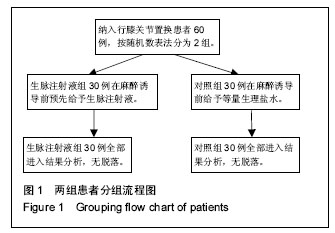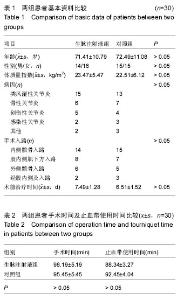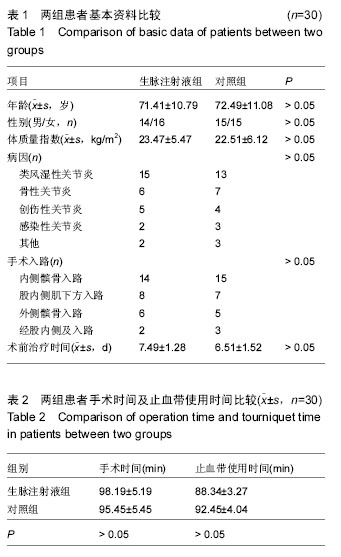Chinese Journal of Tissue Engineering Research ›› 2016, Vol. 20 ›› Issue (53): 7917-7924.doi: 10.3969/j.issn.2095-4344.2016.53.002
Previous Articles Next Articles
Protection of pre-administration of Shengmai injection on ischemia-reperfusion injury of skeletal muscle in lower limb after knee joint replacement
Mei Gao-chang1, 2, Li Yuan-hai1
- 1Department of Anesthesia, the First Affiliated Hospital of Anhui Medical University, Hefei 230022, Anhui Province, China; 2Department of Anesthesia, the First Affiliated Hospital of Anhui University of Traditional Chinese Medicine, Hefei 230031, Anhui Province, China
-
Revised:2016-11-01Online:2016-12-23Published:2016-12-23 -
Contact:Li Yuan-hai, Chief physician, Professor, Doctoral supervisor, Department of Anesthesia, the First Affiliated Hospital of Anhui Medical University, Hefei 230022, Anhui Province, China -
About author:Mei Gao-chang, Master, Attending physician, Department of Anesthesia, the First Affiliated Hospital of Anhui Medical University, Hefei 230022, Anhui Province, China; Department of Anesthesia, the First Affiliated Hospital of Anhui University of Traditional Chinese Medicine, Hefei 230031, Anhui Province, China -
Supported by:the Special Fund for Scientific Research of Doctoral Programs in Colleges and Universities, No. 20133420110009
CLC Number:
Cite this article
Mei Gao-chang, Li Yuan-hai. Protection of pre-administration of Shengmai injection on ischemia-reperfusion injury of skeletal muscle in lower limb after knee joint replacement[J]. Chinese Journal of Tissue Engineering Research, 2016, 20(53): 7917-7924.
share this article
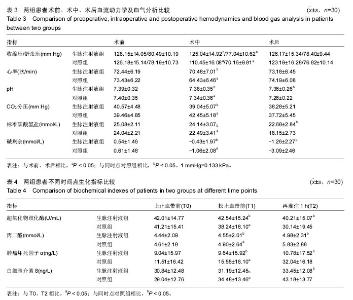
2.3 两组患者手术不同时段血流动力学及血气分析 生脉注射液组患者术前、术中、术后血压、心率、pH、CO2分压、标准碳酸氢盐、碱剩余均无显著变化,差异无显著性意义;对照组患者术中血压下降、心率减慢、CO2分压升高,与术前及术后相比,差异有显著性意义(P < 0.05),而pH、标准碳酸氢盐、碱剩余值逐渐降低,差异有显著性意义(P < 0.05);生脉注射液组术中血压、心率均高于对照组,CO2分压低于对照组,差异有显著性意义(P < 0.05),术中、术后pH、标准碳酸氢盐、碱剩余均高于对照组,差异有显著性意义(P < 0.05),详见表3. 2.4 生化指标 上止血带前(T0)、松止血带前(T1)、再灌注1 h(T2)时测得对照组超氧化物歧化酶活性逐渐下降,差异有显著性意义;而生脉注射液组超氧化物歧化酶活性差异无显著性意义,在T1、T2时,明显高于对照组,差异有显著性意义。对照组丙二醛、肿瘤坏死因子α、白细胞介素8水平均逐渐升高,差异有显著性意义;而生脉注射液组3个生化指标均轻度升高,但差异无显著性意义,而T1,T2时,均明显低于对照组,差异有显著性意义,详见表4。 2.5 不良事件 生脉注射液组共发生不良反应5例,包括过敏性反应3例(皮疹2例、发热1例)、消化系统1例(腹胀)、神经系统1例(头晕),经治疗均好转,无严重并发症,无死亡病例。"

| [1] Brinkman JM, Bubra PS, Walker P, et al.Midterm results using a medial pivot total knee replacement compared with the Australian National Joint Replacement Registry data.ANZ J Surg. 2014;84(3): 172-176.[2] 孙国荣,景克荣,权亚喜,等.生脉注射液对慢性心衰患者心功能及其心率变异性的影响[J].西部中医药,2013,26(4):68-70.[3] Abo-Alhol TR, Fitzpatrick CK, Clary CW, et al.Patellar mechanics during simulated kneeling in the natural and implanted knee.J Biomech. 2014;47(5): 1045- 1051.[4] 鲍航行,王金法,蔡运火,等.全膝关节置换术后止血带性缺血再灌注损伤的临床研究[J].中华创伤骨科杂志,2011, 13(3): 242-246.[5] 张东,李洪祥,陈颖,等.生脉注射液对家兔心肺复苏后多器官功能障碍防治的研究[J].中华急诊医学杂志, 2013, 22(9): 989-993.[6] Beard DJ, Harris K, Dawson J, et al.Meaningful changes for the Oxford hip and knee scores after joint replacement surgery.J Clin Epidemiol. 2015;68(1): 73-79.[7] 刘璇,李正,华声瑜,等.生脉注射液抗大鼠心肌缺血再灌注损伤的药理学研究[J].中成药,2015,37(2):251-255[8] 周明武,李琛琪,杨瑞甫,等.兔肢体缺血再灌注损伤骨骼肌细胞Caveolin-3的变化[J].中华显微外科杂志,2014, 37(4): 368-372.[9] 裴强,赵习德,桑文凤,等.参附注射液与生脉注射液治疗慢性心力衰竭的对比研究[J].中成药,2013,35(3):471-475.[10] 宋莹莹.生脉注射液对慢性心力衰竭患者血清IL-1、IL-8、IL-12和IL-18水平的影响[J].中国老年学杂志, 2013, 33(8):1877-1878.[11] Podsiadlo P, Cicuttini FM, Wolski M, et al.Trabecular bone texture detected by plain radiography is associated with an increased risk of knee replacement in patients with osteoarthritis: A 6 year prospective follow up study. Osteoarthritis Cartilage. 2014;22(1): 71-75.[12] Fitzpatrick CK, Rullkoetter PJ. Estimating total knee replacement joint load ratios from kinematics.J Biomech. 2014;,47(12):3003-3011.[13] 胡蓉.中医药防治心肌缺血再灌注损伤的研究概况[J].现代中西医结合杂志,2009,18(10):1184-1187.[14] 唐帅,徐仲煌,杨宏,等.乌司他丁对双侧全膝关节置换术后患者炎性反应和急慢性疼痛的影响[J].基础医学与临床, 2014,34(4):514-518.[15] Olive DJ,Barrington MJ,Said SA, et al. A randomised controlled trial comparing three analgesia regimens following total knee joint replacement: continuous femoral nerve block, intrathecal morphine or both. Anaesth Intensive Care. 2015;43(4):454-460.[16] Guerra ML, Singh PJ, Taylor NF. Early mobilization of patients who have had a hip or knee joint replacement reduces length of stay in hospital: a systematic review. Clin Rehabil. 2015;29(9):844-854.[17] 詹淑玉,邵青,李正,等.生脉注射液中人参皂苷Rg1,Rb1在心肌缺血大鼠体内的药动学-药效学结合研究[J].中国中药杂志,2014,39(7):1300-1305.[18] 范阜东,陈成,钱军岭,等.生脉注射液在体外循环心肌保护中的作用[J].山东医药,2013,53(4):85-88.[19] 杜景柏,李俊江,徐莺,等.持续生脉注射液静脉注射治疗急性冠脉综合征合并心源性休克的疗效观察[J].中国中西医结合急救杂志,2013,20(5):283-285.[20] 岳燕军,董存元,陈素娟,等.生脉注射液对慢阻肺发作期患者血清BNP、肺功能及氧代谢的影响[J].海南医学,2013, 24(2):225-227.[21] Liu L, Ishijima M, Kaneko H, et al. Disability for daily living is a predictor for joint replacement in patients with end-stage knee osteoarthritis. J Bone Miner Metab. 2014;32(2):192-199.[22] 尹兰英,郝玉苓,王岑,等.生脉注射液对心脏瓣膜置换术丙泊酚全麻患者的心肌保护作用[J].中医杂志,2016,57(8): 686-689.[23] Al-Hadithy N,Patel R, Navadgi B, et al.Mid-term results of the FPV patellofemoral joint replacement.Knee. 2014;21(1):138-141.[24] Engh GA,Sheridan MJ, Ammeen DJ, et al. The Functional Assessment Test: A Method of Evaluating Improvement in Function After Knee Arthroplasty. J Arthroplasty. 2014;29(4):712-718.[25] van der Veen HC, van Raay JJ. Fracture of an Oxford femoral component: A case report. Knee. 2014;21(1): 325-327.[26] Bosco JA, Alvarado CM, Slover JD, et al. Decreasing Total Joint Implant Costs and Physician Specific Cost Variation Through Negotiation. J Arthroplasty.2014; 29(4):678-680.[27] Singh JA, Lewallen DG. Underlying diagnosis predicts patient-reported outcomes after revision total knee arthroplasty. Rheumatology. 2014;53(2):361-366.[28] Hussain SM, Wang Y, Muller DC, et al. Association between index-to-ring finger length ratio and risk of severe knee and hip osteoarthritis requiring total joint replacement.Rheumatology. 2014;53(7):1200-1207.[29] Amiri S, Masri BA, Anglin C, et al. A method for assessing joint line shift post knee arthroplasty considering the preoperative joint space. Knee. 2014; 21(2):359-363.[30] Singh JA, Lewallen DG. Patient-level improvements in pain and activities of daily living after total knee arthroplasty.Rheumatology. 2014;53(2):313-320.[31] 林丽娜,张圣恭,王万铁,等.生脉注射液对兔肺缺血/再灌注损伤时细胞凋亡的影响[J].中国中西医结合急救杂志, 2007,14(6):361-363.[32] 张海龙,赵丽琴,李民,等.七氟醚预处理对全膝关节置换术患者早期康复的影响[J].临床麻醉学杂志,2015,31(9): 862-865.[33] 杨波,康小琴,赵运,等.生脉注射液对不停跳冠脉搭桥术患者氧代谢的影响[J].陕西中医,2013,34(10):1294-1295.[34] 樊旺哲,宋震坤,吴建民.丹参对骨骼肌缺血再灌注损伤影响机制的研究进展[J].医学综述,2009,14(19): 2994-2996.[35] 孙晓莉,郑雪冰,王蕊,等.生脉注射液对心肺复苏中心肌再灌注损伤的保护作用[J].中国实验诊断学,2015,19(8): 1334-1336.[36] 孙晓莉,郑雪冰,周小煊,等.生脉注射液对心肌缺血再灌注损伤家兔肿瘤坏死因子-α及白细胞介素-8的影响[J].中药药理与临床,2008,24(6):8-10.[37] 刘璇,李正,华声瑜,等.生脉注射液抗大鼠心肌缺血再灌注损伤的药理学研究[J].中成药,2015,37(2):251-255.[38] 张晓明.生脉注射液的药理作用机制及临床应用[J].医学综述,2013,19(15):2813-2816.[39] 刘燕君,桂丹,周代伟,等.生脉注射液对失血性休克兔促炎因子肿瘤坏死因子α和IL-6的影响[J].广东医学,2011, 32(1):43-45.[40] 范阜东,陈成,钱军岭,等.生脉注射液在体外循环心肌保护中的作用[J].山东医药,2013,53(4):85-88.[41] Oral E, Neils A, Yabannavar P, et al.The effect of an additional phosphite stabilizer on the properties of radiation cross-linked vitamin e blends of UHMWPE.J Orthop Res. 2014;32(6):757-761.[42] Yang H, Li L, Zhou K, et al. Shengmai injection attenuates the cerebral ischemia/reperfusion induced autophagy via modulation of the AMPK, mTOR and JNK pathways. Pharm Biol. 2016;54(10):2288-2297.[43] Li F, Cheng TF, Dong X, et al. Global analysis of chemical constituents in Shengmai injection using high performance liquid chromatography coupled with tandem mass spectrometry. J Pharm Biomed Anal. 2016;117:61-72. [44] Chen Y, Tang Y, Zhang YC, et al. A metabolomic study of rats with doxorubicin-induced cardiomyopathy and Shengmai injection treatment. PLoS One. 2015;10(5): e0125209. [45] Jiang LP, Zhao J, Cao YF, et al. The Inhibition of the Components from Shengmai Injection towards UDP-Glucuronosyltransferase. Evid Based Complement Alternat Med. 2014;2014:594354. [46] Zhao XP, Kang LY, Tang RM, et al. Strategies and key technologies for risk control and management in quality of Chinese medicine injections based on integrated pharmacology. Zhongguo Zhong Yao Za Zhi. 2014;39(24):4689-4692. [47] Zhan S, Fan X, Zhang F, et al. A proteomic study of Shengmai injection's mechanism on preventing cardiac ischemia-reperfusion injury via energy metabolism modulation. Mol Biosyst. 2015;11(2): 540-548. |
| [1] | Liang Xin, Wang Heng, Li Xian-rong. Preoperative application of alprazolam for patients with anxiety and depression and pain after total knee arthroplasty: its safety and effectiveness [J]. Chinese Journal of Tissue Engineering Research, 2017, 21(7): 985-992. |
| [2] | Shi Bin, An Jing, Chen Long-gang, Zhang Nan, Tian Ye . Influencing factors for pain after total knee arthroplasty [J]. Chinese Journal of Tissue Engineering Research, 2017, 21(7): 993-997. |
| [3] | Wang Xian-xun. Impact of local compression cryotherapy combined with continuous passive motion on the early functional recovery after total knee arthroplasty [J]. Chinese Journal of Tissue Engineering Research, 2017, 21(7): 998-1003. |
| [4] | Lu Yao-jia, Xiong Chuan-zhi, Li Xiao-lei, Hu Han-sheng, Chen Gang, Wang Qiang, Lu Zhi-hua. Comparison of two methods for reducing blood loss during total knee arthroplasty [J]. Chinese Journal of Tissue Engineering Research, 2017, 21(7): 1004-1008. |
| [5] | Yuan Wei, Zhao Hui, Ding Zhe-ru, Wu Yu-li, Wu Hai-shan, Qian Qi-rong. Association between psychological resilience and acute mental disorders after total knee arthroplasty [J]. Chinese Journal of Tissue Engineering Research, 2017, 21(7): 1015-1019. |
| [6] | Chen Qun-qun, Qiao Rong-qin, Duan Rui-qi, Hu Nian-hong, Li Zhao, Shao Min. Acu-Loc®2 volar distal radius bone plate system for repairing type C fracture of distal radius [J]. Chinese Journal of Tissue Engineering Research, 2017, 21(7): 1025-1030. |
| [7] | Huang Xiang-wang, Liu Hong-zhe. A new low elastic modulus of beta titanium alloy Ti2448 spinal pedicle screw fixation affects thoracic stability: biomechanical analysis [J]. Chinese Journal of Tissue Engineering Research, 2017, 21(7): 1031-1035. |
| [8] | Xie Qiang. Three-dimensional finite element model for biomechanical analysis of stress in knee inversion and external rotation after posterior cruciate ligament rupture [J]. Chinese Journal of Tissue Engineering Research, 2017, 21(7): 1036-1040. |
| [9] | He Ze-dong, Zhao Jing, Chen Liang-yu, Li Ke, Weng Jie. Multilevel finite element analysis on the biological tribology damage of water on bone tissue [J]. Chinese Journal of Tissue Engineering Research, 2017, 21(7): 1041-1045. |
| [10] | Jiang Zi-wei, Huang Feng, Cheng Si-yuan, Zheng Xiao-hui, Sun Shi-dong, Zhao Jing-tao, Cong Hai-chen,Sun Han-qiao, Dong Hang. Design and finite element analysis of digital splint [J]. Chinese Journal of Tissue Engineering Research, 2017, 21(7): 1052-1056. |
| [11] | Wang Fei, Liu Zhi-bin, Tao Hui-ren, Zhang Jian-hua, Li Chang-hong, Cao Qiang, Zheng Jun, Liu Yan-xiong, Qu Xiao-peng. Clinical efficacy of preoperative osteotomy designs using paper-cut technology versus photoshop software for ankylosing spondylitis with kyphosis [J]. Chinese Journal of Tissue Engineering Research, 2017, 21(7): 1057-1063. |
| [12] | Li Hui, Ma Jun-yi, Ma Yuan, Zhu Xu . Establishment of a three-dimensional finite element model of ankylosing spondylitis kyphosis [J]. Chinese Journal of Tissue Engineering Research, 2017, 21(7): 1069-1073. |
| [13] | Ling Guan-han, Ou Zhi-xue, Yao Lan, Wen Li-chun, Wang Guo-xiang, Lin Heng-feng. Establishment of simulating three-dimensional model of China-Japan Friendship Hospital Classification for L type osteonecrosis of the femoral head [J]. Chinese Journal of Tissue Engineering Research, 2017, 21(7): 1074-1079. |
| [14] | Fu Wei-min, Wang Ben-jie. Assessing the degree of necrotic femoral head, and association of blood supply with pathlogical changes: study protocol for a diagnostic animal trial [J]. Chinese Journal of Tissue Engineering Research, 2017, 21(7): 1086-1091. |
| [15] | Zhang Wen-qiang, Ding Qian, Zhang Na. Associations between alpha angle and herniation pit on oblique axial magnetic resonance imaging in asymptomatic hip joints of adults [J]. Chinese Journal of Tissue Engineering Research, 2017, 21(7): 1098-1103. |
| Viewed | ||||||
|
Full text |
|
|||||
|
Abstract |
|
|||||
